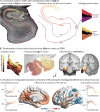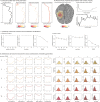The BigBrainWarp toolbox for integration of BigBrain 3D histology with multimodal neuroimaging
- PMID: 34431476
- PMCID: PMC8445620
- DOI: 10.7554/eLife.70119
The BigBrainWarp toolbox for integration of BigBrain 3D histology with multimodal neuroimaging
Abstract
Neuroimaging stands to benefit from emerging ultrahigh-resolution 3D histological atlases of the human brain; the first of which is 'BigBrain'. Here, we review recent methodological advances for the integration of BigBrain with multi-modal neuroimaging and introduce a toolbox, 'BigBrainWarp', that combines these developments. The aim of BigBrainWarp is to simplify workflows and support the adoption of best practices. This is accomplished with a simple wrapper function that allows users to easily map data between BigBrain and standard MRI spaces. The function automatically pulls specialised transformation procedures, based on ongoing research from a wide collaborative network of researchers. Additionally, the toolbox improves accessibility of histological information through dissemination of ready-to-use cytoarchitectural features. Finally, we demonstrate the utility of BigBrainWarp with three tutorials and discuss the potential of the toolbox to support multi-scale investigations of brain organisation.
Keywords: anatomy; histology; human; multi-modal; neuroimaging; neuroscience.
© 2021, Paquola et al.
Conflict of interest statement
CP, JR, LL, CL, TG, KW, JD, SV, LC, AK, KA, AE, TD, BB none, PT None
Figures







References
Publication types
MeSH terms
Grants and funding
LinkOut - more resources
Full Text Sources

